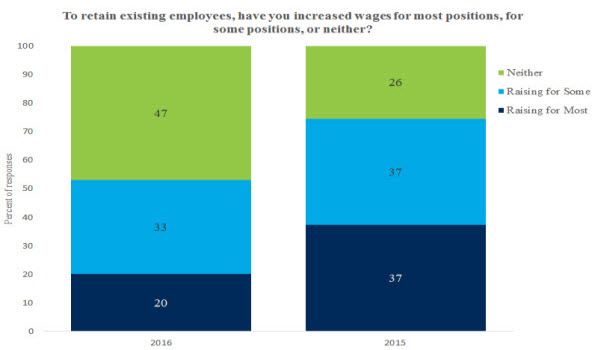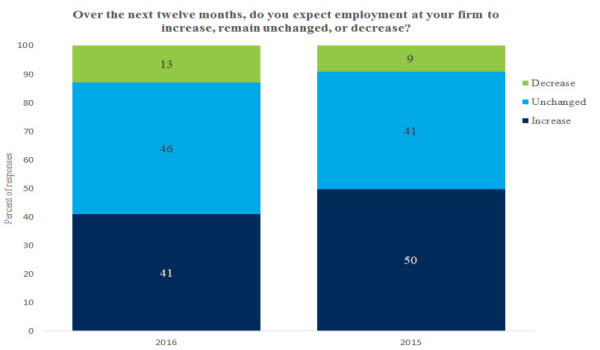Survey Says: Employers' Hiring and Wage Plans
Employers in the Richmond Federal Reserve District have commented on difficulties finding qualified workers for open positions. At the less skilled end of the spectrum, hospitality, restaurant, and retail organizations are competing for the same pool of workers. At the other end of the hiring spectrum, in high-skill fields such as information technology, companies try to lure hard-to-find workers away from other firms. Between the polar ends of the spectrum, challenges have been reported in finding medical technicians, machinists, and construction workers, to name a few.
We surveyed employers across a wide variety of businesses to find out more. We asked about hiring plans, employee retention, availability of qualified candidates for openings, and wage trends. From those polled, 135 started the questionnaire that was open from the end of April to late May in 2016, although some respondents did not answer every question. Employers were asked about their ability to retain employees over the past 12 months. Only 6 percent said it has become easier, while 31 percent reported greater difficulty in retaining employees, and most (63 percent) indicated no change. Just over half of employers surveyed (53 percent) reported that they were increasing wages and salaries more than in the past few years in an effort to retain employees.
When asked about their hiring plans over the next 12 months, 46 percent of the firms planned no change, while 41 percent intended to increase employment, and 13 percent planned to decrease employment. Of those employers that are actively hiring, either to replace departing workers or expand their workforce, 38 percent said that, in general, they currently do not have enough qualified job candidates from which to fill job vacancies, and 34 percent said they have enough except for in some job categories.
Similar questions were posed to employers in a survey at the same time last year. Relative to the 2016 survey, there were some notable differences in the use of wage increases as a tool to retain employees as well as plans to increase employment. In 2015, less than a third of employers (28 percent) reported that it had become harder to retain workers over the preceding 12 months. While this sentiment had not changed much by the time of the 2016 survey, the use of wage and salary increases to retain existing employees had changed, with a combined 74 percent using this approach in 2015, but only 53 percent reporting this tactic in 2016.
With regard to hiring plans, a year ago 50 percent of employers planned to increase employment over the next 12 months, compared to only 41 percent planning to do so at the time of the 2016 survey.
In the 2016 survey, employers were given a list of possible reasons for the shortage of qualified candidates for job openings, and they were asked to rank their top three factors. What do employers name as the most important factor leading to a shortage of qualified candidates? “Applicants lack the specific skills and/or experiences required for our vacancies,” according to 50 percent of employers, while another 33 percent said they had “too few applicants per vacancy.” Those reasons were also named most frequently as the second most important factor along with “applicants appear to lack soft skills generally required for employment (e.g., punctuality, appropriate appearance or demeanor, etc.).” Additional factors selected as the third most important included “applicants’ compensation demands are too high for our vacancies,” “applicants fail basic employment screening (e.g., drug tests, criminal background checks, literacy skills, etc…),” and “applicants appear to lack soft skills generally required for employment (e.g., punctuality, appropriate appearance or demeanor, etc.).”
Our survey results indicate that employers in the Fifth District view the labor market as somewhat tight in view of their difficulty retaining current employees or finding qualified candidates for job openings. Nonetheless, the number of firms that expect to increase employment over the next 12 months greatly outweighs the number that plan to shrink their payrolls. This is consistent with our monthly surveys of manufacturing and service sector activity, which have registered gains in current employment in both sectors and expected gains in manufacturing employment over the next six months (this is not reported for the service sector). Our monthly surveys are available here.
Have a question or comment about this article? We'd love to hear from you!
Views expressed are those of the authors and do not necessarily reflect those of the Federal Reserve Bank of Richmond or the Federal Reserve System.



